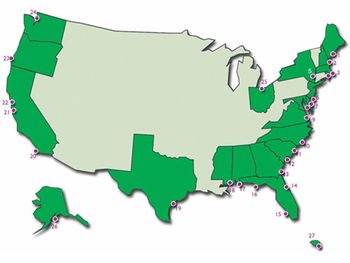US National Estuarine Research Reserve System
The United States National Estuarine Research Reserve System (NERRS https://coast.noaa.gov/nerrs/) was established as an element of the Coastal Zone Management Act of 1972. It creates a representative system of locally managed estuarine reserves that conduct long-term research, water quality monitoring and educational programs designed to promote coastal stewardship. As of 2008, this network of protected areas includes 27 reserves. The program oversees more than one million acres (4,000 km²) of estuarine land, wetlands, and water.
Contents
Goals and Priority Issues
NERRS is structured as a partnership between individual states and the Federal Government and is the research arm of the U.S. Coastal Zone Management Program. The U.S. National Oceanic and Atmospheric Administration (NOAA) within the Department of Commerce administers the program. The goal of NERRS is to conduct long-term research and education on, and promote stewardship of, coastal wetlands and estuaries in a range of sites from those that are pristine to those heavily impacted. Strategic goals for 2005-2010 are to “strengthen the protection and management of representative estuarine ecosystems to advance estuarine conservation, research and education; increase the use of reserve science and sites to address priority coastal management issues; and enhance people’s ability and willingness to make informed decisions and take responsible actions that affect coastal communities and ecosystems (NOAA website).”
A NERRS priority is to communicate research findings to coastal managers. The system’s 2005-2010 Strategic Plan identifies four priority national issues for research: impacts of land use and population growth; habitat loss and alteration; water quality degradation; and changes in biological communities.
Governance Framework of the Program
The process for designating new NERRs begins when a state governor submits a letter of interest to NOAA requesting funds to identify a site and select the local lead agency. If NOAA approves the request, it provides up to $100,000 (a 50% match from the state is required) to select the site and prepare a basic characterization of the site’s physical, chemical and biological characteristics; an Environmental Impact Statement; and a Management Plan. NOAA requires extensive public participation and collaboration in the designation process.
Management partners in a NERR may include state agencies, non-profit groups, universities and members of the local community. The NERR may also work with SeaGrant extension and education staff and others in identifying key coastal resource issues to address.
Core Programs
NOAA provides annual core funding and the state must provide matching funds. Combined, these are used to develop management plans, conduct school and public education programs, maintain reserve facilities and acquire new properties. As a national system of protected areas, the NERRS conducts the following core programs at each site:
- System-wide Monitoring Program: tracks changes over the long-term to understand how human activities and natural events impact coastal ecosystems
- Graduate Research Fellows Program: provides students the opportunity to conduct research at a reserve
- Coastal Training Program(CTP): targets the needs of local decision-maker by offering information, skills building, lectures, and demonstration projects and providing networking opportunities that can foster new collaborative solutions
- School and Public Education Programs: build stewardship for coastal estuaries within the general public. NERRS is mandated "to enhance public awareness and understanding of estuarine areas, and provide suitable opportunities for public education and interpretation." Most reserves provide experiential education programs for elementary and secondary schools. The Estuary Live program enables students to learn over the internet.
- Stewardship through working with the surrounding local communities to participate in such activities as land acquisition, restoration habitat mapping and policy development.
The NERRS, NOAA and state coastal management programs work together with the Cooperative Institute for Coastal and Estuarine Environmental Technology (CICEET) to produce practical tools for restoring and managing coastal ecosystems.
See also
Internal Links
- Estuary
- Channel Islands National Marine Sanctuary – Case Study
- US Coastal Zone Management Program
- Coastal Barrier Resources System
- Overview of Coastal Habitat Protection and Restoration in the United States
- Essential Fish Habitat
- Chesepeake Bay Program
- Clean Water Act
- US National Estuary Program
- US National Marine Sanctuaries
- US National Wildlife Refuge System
- Rhode Island Salt Pond Special Area Management Plan – Case Study
- US Sea Grant College Program
- Tampa Bay Estuary Program
- US Army Corps of Engineers’ Coastal Programs
External Links
- NERRS Homepage https://coast.noaa.gov/nerrs/
- Estuaries EPA https://www.epa.gov/nep
- Coastal and Estuarine Research Federation http://erf.org/
- National Estuarine Research Reserve Association http://nerra.org/
- Cooperative Institute for Coastal and Estuarine Environmental Technology http://worldoceanobservatory.org/directory-listing/cooperative-institute-coastal-and-estuarine-environmental-technology-ciceet
References
Please note that others may also have edited the contents of this article.
|
